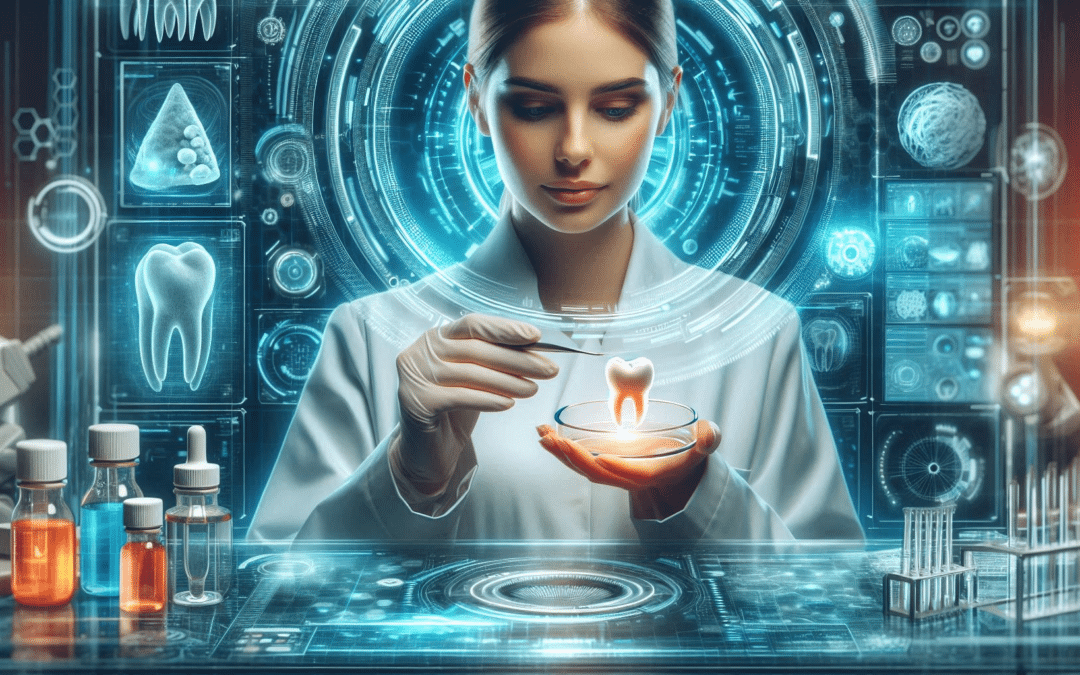The field of dentistry is evolving rapidly, with revolutionary technologies transforming what’s possible in dental care. Following our exploration of tooth regeneration from stem cells, we’re excited to delve deeper into the future of dental health. This article highlights not only the potential for regrowing teeth but also the modern alternatives that are reshaping dental practices today.
Advanced Dental Implants
While the possibility of regrowing teeth from stem cells is still on the horizon, advanced dental implants are here today, offering a robust and reliable solution for tooth loss. Modern implants have come a long way in both material and design sophistication, designed to integrate seamlessly with your jawbone, mimicking the look, feel, and function of natural teeth.
Titanium vs. Zirconia Implants
Traditionally, titanium has been the material of choice for dental implants due to its strength, durability, and excellent biocompatibility, allowing for effective osseointegration with the jawbone. However, recent advancements have seen the rise of zirconia implants, which are favored for their aesthetic qualities—they do not show a metallic line at the gum as titanium can. Despite their advantages, zirconia implants have not caught on as quickly as titanium in the U.S. primarily due to their relative novelty and the lack of long-term studies proving their superiority over the well-established titanium options.
Bioengineered Materials
Bioengineered materials are revolutionizing dental restorations by providing solutions that are not only durable but also biocompatible. These materials are designed to integrate with the body’s natural tissues, promoting better healing and a more natural response within the mouth.
Examples of Bioengineered Materials
- Composite Resins: Improved to better mimic the natural appearance of teeth while providing durability.
- Ceramic Compounds: Including advanced porcelains and ceramics used in crowns and veneers, which offer excellent color matching and resistance to wear.
- Zirconia: Mentioned earlier, it’s also part of the bioengineered category for its aesthetic and hypoallergenic properties, making it ideal for patients with metal sensitivities.
Key Differences in Implant Designs:
Titanium Implants
- Two-piece system: Most titanium implants feature a separate abutment that screws onto the implant. This design allows for a high degree of customization in terms of the abutment’s shape, angle, and the type of crown that can be attached. It also facilitates easier adjustments or replacements of the crown without disturbing the implant.
- Versatility: The separate abutment provides more options for dealing with various anatomical challenges, such as angled implants in areas with limited space or uneven bone levels.
Zirconia Implants
- One-piece design: Many zirconia implants are designed as a single unit, where the implant and the abutment are integrated. This can simplify the surgical procedure and reduce the risk of bacterial build-up between the abutment and the implant that might occur in two-piece designs. However, it limits the adjustability of the implant’s protrusion and angle once placed.
- Aesthetic and biocompatibility: Zirconia is chosen for its aesthetic qualities and biocompatibility, making it a favorable option especially in the visible areas of the mouth. However, the one-piece design can be a limitation in terms of prosthetic flexibility and customization.
Clinical Implications:
The one-piece nature of many ceramic implants means that once they are placed, the options for adjusting the position or angle of the abutment are limited, potentially making the final placement of the crown more challenging. This can be particularly problematic in cases where precise alignment and fit are crucial for aesthetic or functional reasons. Additionally, if the crown or the implant needs repair or replacement, the entire unit might need to be addressed, which can complicate and increase the cost of maintenance.
While ceramic implants offer excellent aesthetic and biocompatible properties, their one-piece design can pose challenges for dental restoration, particularly when compared to the versatility offered by the two-piece titanium systems. It’s important for patients and clinicians to consider these factors when choosing the most suitable implant material and design for their specific needs.
Cutting-edge Dental Technologies
The future of dental health is also being shaped by cutting-edge technologies that make treatments more efficient and less invasive. Here’s how digital dentistry is playing a crucial role:
Digital Dentistry and the Patient Experience
Digital dentistry, including 3D imaging and computer-aided design/computer-aided manufacturing (CAD/CAM), allows for precise diagnostics and personalized treatment planning. This technology not only improves the accuracy of treatments but also significantly enhances the patient experience by reducing the time spent in the dental chair and increasing comfort. Digital impressions for crowns or aligners are faster, more comfortable, and more accurate than traditional methods, leading to better fitting and more effective dental appliances.
As we continue to explore and develop these advanced technologies, the future of dental health looks brighter than ever. While we await the day when teeth regeneration becomes a commonplace procedure, these modern alternatives provide effective and innovative solutions for today’s dental challenges. By staying informed about these advancements, you can make the best choices for your dental health and keep your smile bright and healthy for years to come.
Stay ahead of the curve by visiting our blog regularly for updates on the latest innovations in dental care. Your smile deserves nothing less than the cutting edge!




